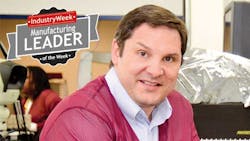One Proven Way to Solve Your Skilled Workforce Problems
Firstronic LLC, the Grand Rapids, Mich.-based electronics manufacturer continues to defy the odds with regard to producing electronics products in the U.S., business growth and, we've recently learned, hiring and retaining skilled production workers. In previous articles, I've detailed Firstronic CEO John Sammut's strategy for success in the former two; this article shares his successful strategy for the latter.
But first an update: "We're looking at another 50% growth this year," Sammut says, adding that the increase comes from "doing even more business with customers that know us" as well as a new customer for which Firstronic will produce product "that was off shore or heading offshore."
Along with the new business, Firstronic has added more automation to increase capacity. Specifically, it has added high-speed surface mount technology (SMT) circuit board assembly lines, Solder Paste Inspection, and automated optical inspection. The new equipment still leaves room for more, Sammut notes. "With our footprint, we can add another fully automated SMT line inside of about 5 thousand square feet."
While other growing U.S. manufacturers complain about the difficulty of finding and hiring new skilled employees to meet growing demand, Sammut has that figured out as well. He leverages a custom approach that involves each step in the process, from finding and hiring to training and retaining.
The Wiring is Critical to Good Hiring
The first screen is verifying that the candidate has a high school diploma or GED, but the next step is most important: evaluating candidates to see if they are the "right fit."
Firstronic has each candidate complete an assessment survey to determine if they have an aptitude for the type of production work at Firstronic. "It's not whether they are good or bad, but [to learn] 'is this type of work going to fit this person,'" Sammut explains.
The work for a typical production worker at Firstronic involves interacting with machines, performing some repetitive tasks, and getting everything—components, placement, etc.—right.
"We need to know if this type of work is going to be a fit with this person," Sammut explains. "Would they be inclined to do this repetitively and continue to focus on the demands of our type of electronics assembly work?"
He notes that some people are more abstract, while for others "it's critical to distinguish various components and circuits," Sammut explains. "We have discovered this ability has more to do with wiring—not personality—but cognitive wiring."
Each candidate takes a 10-minute online survey, which is called the AcuMax Index, developed by Jay Hawreluk. "It's a quick survey where there are no right or wrong answers, but tells us the environment in which a person best thrives," Sammut says.
Sammut believes that this assessment is invaluable. "We've always been eager to use technology to find the right people," Sammut says. "We spend a lot of time and money training, and we don't want to pick the wrong people."
Sammut's entire team took the AcuMax Index and decided they'd found the right tool. "We looked at each other and said, 'Wow! It shouldn't be that simple,' but it works, it's unbeatable," Sammut asserts. "We started using it across the board, even with our existing staff, the ones who have done so well that we want to find more like them. And then we decided to use it for candidates."
"It's a win-win—we increase product quality and customer satisfaction, and the employee wants to advance, so they develop more skills."
Twenty-five to thirty percent of the people [who are screened] end up being a good fit, Sammut notes. Only those who do go on to the next step in the hiring process.
Intensive and extensive training
"We can't find people with electronic assembly experience in [Grand Rapids], so we bring them in with no qualifications and proceed to train and certify new people almost to the level of certified electronic technicians," Sammut says.
"These workers go through a 90-day probationary period where we note performance, attendance, attitude, eagerness to learn, propensity to advance," Sammut explains. "We have 30-, 60- and 90-day checkpoints. At the end of the 90-day review period, the employee gets benefits—401k, a pay increase, etc.,—and they become long-term employees." Firstronic also continues to invest in workforce development.
Decreasing Turnover
Sammut credits the screening combined with the 90-day probationary training period for a low single-digit turnover rate. "We find once the new worker gets past 90 days, and we see there is a good fit, the turnover drops dramatically." Within the first 90 days, the turnover can be 25%, Sammut estimates.
As well, knowing the "wiring" of new employees provides information about the leadership and management approaches that work best to keep the employee engaged, according to the AcuMax Index.
With 220 North American and 600 global employees, good hiring and development is critical to Firstronic's success and long-term growth strategy, Sammut declares: "The difference between succeeding long-term and floundering—huge success and being an also-ran—is just getting the right workforce in place."
Finding a Competitive Position in a Global Market
Overall, Sammut believes that Firstronic is leading the reshoring trend. "Over the past 2 years, we've doubled our revenue and currently 75% of our production gets exported to Mexico, Korea, China and India," Sammut says. "We think as the Chinese currency continues to appreciate relative to the dollar, this will become a megatrend—the competitiveness of this region relative to Asia will increase until the trend lines cross.
"In China, the wages are going up, turnover is going up, and overall it's becoming more difficult to do production.
"We have seen numerous programs return to North America for volume production, and we are demonstrating that we can be very competitive, offering a compelling proposition when our customers evaluate the total landed cost of their products."
About the Author
Patricia Moody
Publisher
Patricia E. Moody is a writer and manufacturing and supply management consultant with over 30 years of management consulting, hundreds of articles and interviews, speeches, and 12 books to her credit. She is the publisher of Blue Heron Journal, an online resource for thought-leaders and decision makers.
Named by FORTUNE magazine one of the "Ten Pioneering Women in Manufacturing," she was featured on CNN's "21ST CENTURY WITH BERNARD SHAW." Her consulting client list includes Motorola, Respironics, British Petroleum, Waste Management, and Cisco. She consulted to Johnson & Johnson's McNeil Consumer Labs during the Tylenol poisoning crisis and is credited with saving the company. She has an MBA and an Honorary Doctorate.
A pragmatic visionary and self-confessed technology freak, she has little patience for laggards who have dwelled too long on one-note methodologies. She believes that a combination of technology, clear process, and progressive leadership, funded by smart spend management can save endangered companies.


